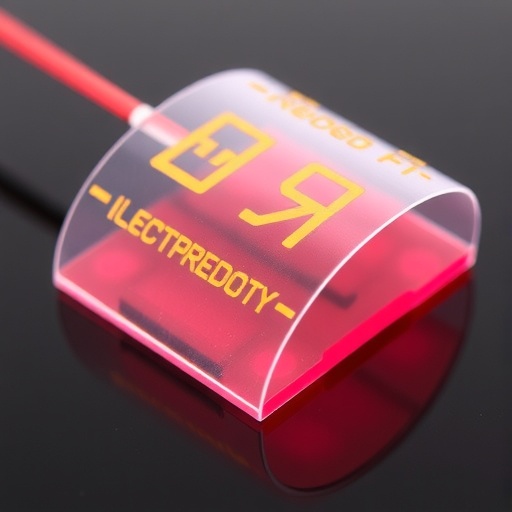
In the rapidly evolving landscape of flexible and wearable electronics, the quest for materials and device architectures that seamlessly combine robustness, flexibility, and high performance remains a driving force behind cutting-edge research. A recent breakthrough study heralds a transformative approach in the development of organic electrochemical transistors (OECTs), leveraging the power of electropolymerized poly(3,4-ethylenedioxythiophene) (PEDOT). This advancement not only pushes the boundaries of device stability and mechanical compliance but also paves the way for next-generation bioelectronic applications that require intimate and enduring interfaces with biological systems.
Organic electrochemical transistors have gained widespread attention for their unique ability to transduce ionic signals into electronic currents, an essential functionality for bioelectronic sensors, neural interfaces, and flexible circuits. However, one of the persistent challenges in this field has been the simultaneous achievement of mechanical durability and electrical stability under repeated bending, stretching, and exposure to humid physiological environments. Conventional PEDOT-based materials, often fabricated via solution processing or vapor phase polymerization, have struggled to maintain robust performance under these demanding conditions.
The study at hand introduces a novel methodology centered around the electropolymerization of PEDOT directly onto flexible substrates, leading to the formation of a well-structured and conformal thin film that adheres strongly to the underlying surface. This process circumvents many limitations associated with traditional coating techniques by promoting uniform polymer growth driven by electrochemical reactions. The electropolymerized PEDOT films exhibit enhanced mechanical integrity, maintaining their conductive pathways even under substantial mechanical deformation.
.adsslot_aSqtPBEmyN{width:728px !important;height:90px !important;}
@media(max-width:1199px){ .adsslot_aSqtPBEmyN{width:468px !important;height:60px !important;}
}
@media(max-width:767px){ .adsslot_aSqtPBEmyN{width:320px !important;height:50px !important;}
}
ADVERTISEMENT
One of the critical insights delivered by the research is the intimate relationship between the polymerization conditions and the resulting microstructure of the PEDOT films. By carefully tuning the electropolymerization parameters such as voltage cycles, monomer concentration, and electrolyte composition, the authors achieved films with optimized roughness, porosity, and doping levels. This fine control allowed the fabrication of OECT channels that balance ionic transport efficiency with electronic conductivity, a balance vital for ultimate device responsiveness and signal-to-noise ratio.
The research also delves deeply into the characterization of the electrochemical and mechanical properties of the fabricated devices. Systematic bending and stretching tests demonstrated that the electropolymerized PEDOT-based OECTs preserved their current modulation capabilities despite repeated mechanical stresses. This robustness underscores the practical viability of these devices in wearable contexts where curvature and movement are unavoidable. Furthermore, electrochemical impedance spectroscopy and cyclic voltammetry measurements verified the electrodes’ stability and rapid ion exchange kinetics, contributing to their overall superior performance.
Another compelling aspect of this work is its potential applications in bioelectronic interfaces. Because OECTs convert ionic signals into readable electronic output, their use in monitoring biochemical markers, neural activity, and muscle signals is particularly promising. The flexible and robust nature of the electropolymerized PEDOT channels ensures reliable operation over extended time frames, an essential feature for chronic implantation or long-term health monitoring.
In addition to performance improvements, the manufacturing approach described in the study suggests scalability and compatibility with existing flexible electronics fabrication pipelines. The electropolymerization process is relatively low-cost and environmentally benign, using aqueous electrolytes and ambient conditions, aligning well with green chemistry imperatives. This characteristic promises to accelerate the integration of OECTs into commercial biomedical devices and consumer electronics.
The findings also open up new research avenues by enabling the exploration of composite and hybrid electrode materials through sequential or co-electropolymerization techniques. By incorporating functional dopants or blending PEDOT with biocompatible polymers, future devices could further tailor their electrochemical response and mechanical properties to specific applications, such as soft robotics or implantable sensors.
Importantly, the research addresses a long-standing trade-off in flexible electronics: mechanical flexibility versus electrical performance. The electropolymerized PEDOT films uniquely reconcile these two often competing criteria, offering a robust pathway to devices that can bend, twist, and conform without sacrificing signal fidelity or operational longevity.
From a broader perspective, the advance described highlights the transformative role of electropolymerization in organic electronics. This technique allows precise control over polymer growth and morphology at the nanoscale, which is crucial for the fine-tuning of device interfaces and the achievement of high-performance flexible circuits that interact intimately with living tissues.
The meticulous design of the electropolymerization protocols also demonstrates an exemplary synergy between material science and electrochemistry. Understanding the dynamics of monomer oxidation and dopant incorporation during film formation enables optimization that transcends phenomenological improvements, providing mechanistic clarity and rational pathways for further enhancement.
In practical terms, devices incorporating electropolymerized PEDOT OECTs could revolutionize health monitoring technologies. For instance, they may enable continuous, non-invasive monitoring of ion concentrations in sweat or interstitial fluids, providing insights into hydration, electrolyte balance, or disease biomarkers in real time. The flexibility and endurance of these devices mean that user comfort and device lifespan can be vastly improved compared to rigid, brittle sensors.
The implications of this breakthrough are not limited to healthcare. In the emerging Internet of Things (IoT) ecosystem, flexible organic electronics capable of reliable operation under diverse mechanical stresses are indispensable. Electropolymerized PEDOT-based OECTs could act as fundamental components in smart fabrics, environmental sensors, or human-machine interfaces that demand durability and responsiveness combined with conformability.
It is evident that this research represents a significant leap forward in the material engineering of organic electrochemical devices. By embracing electropolymerization to generate PEDOT films with superior mechanical and electrical properties, the study provides a blueprint for fabricating next-generation flexible transistors that do not compromise functionality for flexibility.
Moreover, the multidisciplinary approach encompassing materials chemistry, device physics, and biointerface engineering exemplifies the collaborative efforts necessary to surmount challenges in wearable and implantable electronics. This integrative strategy effectively bridges the gap between laboratory innovation and real-world application.
As flexible electronics continue to permeate daily life, driven by advances like those outlined here, the seamless amalgamation of electronics with the human body and environment appears increasingly feasible. Electropolymerized PEDOT channels stand at the forefront of this evolution, promising devices that are as resilient and adaptable as the biological systems they aim to monitor and augment.
Ultimately, the work underscores the critical importance of electropolymerization as a versatile, precise, and scalable technique to elevate organic electronic materials. Its implementation in OECTs marks a turning point that could broadly impact not only electronics but also the fields of medicine, environmental science, and beyond, fueling innovation for years to come.
Subject of Research: Organic Electrochemical Transistors (OECTs) fabricated via electropolymerized PEDOT for robust and flexible bioelectronics applications.
Article Title: Robust and flexible organic electrochemical transistors enabled by electropolymerized PEDOT.
Article References:
Wang, M., Fan, J., Bilodeau-Calame, M. et al. Robust and flexible organic electrochemical transistors enabled by electropolymerized PEDOT. npj Flex Electron 9, 74 (2025). https://doi.org/10.1038/s41528-025-00457-w
Tags: bioelectronic sensor technologydurable flexible electronicselectropolymerized PEDOT applicationsflexible circuit designshigh-performance organic transistorsionic signal transductionmechanical durability in electronicsneural interface advancementsorganic electrochemical transistorsPEDOT thin film fabricationstability in humid environmentswearable electronic devices






